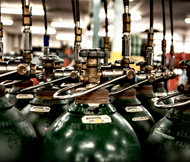Trade in industrial gases

The main industrial gases - oxygen, nitrogen and argon obtained by cryogenic air separation. This production technology was developed over 100 years ago.
For the separation of compressed air, purified from carbon dioxide, moisture and dust, and then cooled to a very low temperature (about - 175 ° C). Liquefied with cooling air by distillation (distillation) is separated into oxygen, nitrogen, argon and other inert gases.
Currently used as other air separation methods:
- 1. Separation: air separation by means of membranes.
- 2. Adsorption: air is passed through a special materials which absorb some of its components.
Learn more about the main industrial gases and their properties is available here
Open to cooperation
“...We have carefully and responsibly work with our clients, welcome new partners and are ready to cooperate....”
We are interested in developing closer trade relations and achieving inclusive and sustainable economic growth. The plane is the common interests and opportunities with respect to the supply of industrial gases, food and agriculture, transportation and logistics.
To establish contact with our representative, please contact using the information provided here
Transportation and Logistics in the EU
The global market for road transport is one of the the most dynamic in comparison with other markets types of transport services. In recent years the market of automobile transportation considerably increases in volume due to the high the demand for these services as at businesses and at individuals. You receive a large number of new transport companies, prefer to work in this area despite the fact that the financial the threshold of entry into the market of transportation is rather high.
“..In terms of road transport in the first six EU countries included Germany, Poland, Spain, France, Italy and Great Britain...”
According to experts, international road freight EU transport consists mainly of bilateral traffic between EU Member States (82%), 15% from transport with third countries and 3% - on cabotage. For the European Union as a whole, the level of penetration of cabotage is not more than 1%. Belgium, France and Denmark have the highest penetration rate cabotage.
Requirements for the delivery of food in the EU
The main aim of the European legislation on food safety is to ensure a high level of protection of public health and consumer interests in relation to food, in turn, feed on the EU rules aimed at protecting public and animal health and, to a certain extent, to protect the environment.
Regulation of the European Parliament and of the Council number 178/2002 (OJ L-31 02/01/2002) lays down the general principles and requirements of food law and covers all stages of food and feed production and distribution. Importers of food and feed products are required to specify the register and exporting products in the country of origin in order to meet the requirements of its tracking.
At importation into the EU of certain agricultural products may require the presentation of a certificate for import, issued by the competent authority of the Member State before customs clearance for the release of goods in free circulation at the request of the importer and security deposit, refundable upon presentation of proof of import. Certificates on imports serve different purposes, such as monitoring trade flows, the establishment of tariff quotas or providing protective measures.
